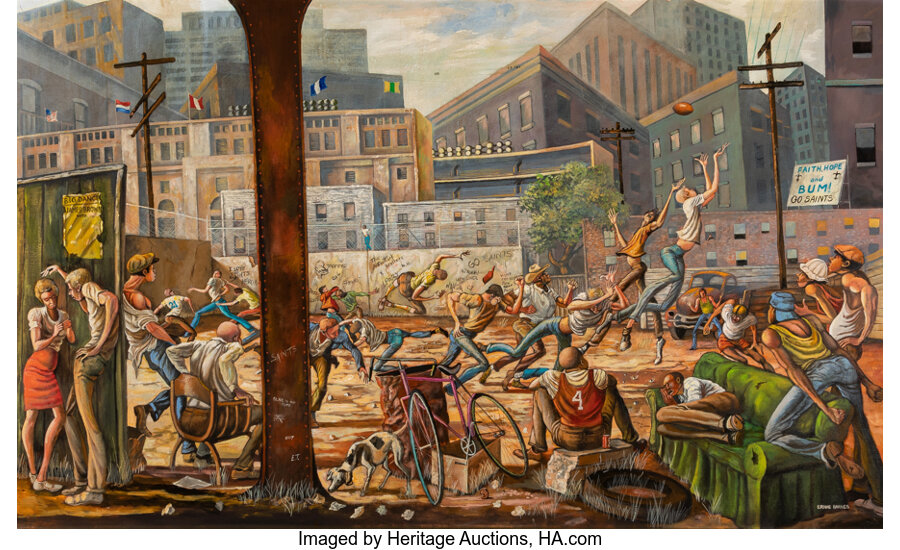Ernie Barnes (American, 1938-2009) Sandlot Saints, 1982 Acrylic on canvas 36 x 60 inches (91.4 x 152.4 cm) Signed lower right: Ernie Barnes Masterworks of Sport and Spirit: Property from the Collection of John W. Mecom Jr. PROVENANCE: The artist; Commissioned by the present owner from the above, 1982 (originally titled Sandlot Football). Ernie Barnes's Sandlot Saints is a vibrant and evocative homage to the spirited community rituals of the American South, athletic tradition, and the cultural heartbeat of New Orleans. Executed in Barnes's distinctive neo-mannerist style—characterized by elongated forms, dynamic motion, and emotionally charged figuration—the painting captures a moment suspended between everyday activity and sacred communal expression. More than merely depicting a football game, Barnes transforms the scene into a tableau rich with memory, pride, and collective identity, articulated through his unmistakably expressive visual language. Born in 1938 in Durham, North Carolina, at the height of the Jim Crow era, Barnes's formative years were shaped by segregation in the economically marginalized neighborhood known as "The Bottom." His father, Ernest Barnes Sr., worked as a shipping clerk for Liggett & Myers Tobacco Company, while his mother, Fannie Geer, served as head housekeeper for a local attorney. It was through her employer—who generously shared his extensive collection of art books and catalogs—that Barnes first encountered the visual arts, as entry to museums had often denied him due to racial barriers. Sandlot Saints embodies Barnes's personal history as both an athlete and an acute observer of American culture. Set in a vacant New Orleans lot situated between a towering football stadium and a rusting overpass, the painting vividly portrays a local community engaged in their own spirited match—played, perhaps literally, in the shadow of the Saints' official games. Here, however, the spotlight firmly belongs to local players, who twist, dive, and sprint across the canvas. Barnes's distinctive elongation of forms imbues the figures with a kinetic energy reminiscent of both mannerist compositions and cinematic choreography, creating a rhythmic visual narrative that energizes the entire composition. Surrounding the action is a richly textured and diverse community, grounded firmly in the urban vernacular. Spectators lean casually against fences, perch atop discarded bricks, or lounge on a worn green couch as the game unfolds around them. The walls of the sandlot, adorned with neighborhood graffiti and slogans such as "Go Saints," anchor the work firmly in the lived realities of city life. Significantly, the crowd itself reflects a diverse gathering of races and ages, reinforcing Barnes's deliberate portrayal of an America that is more integrated and hopeful than the one into which he was born. While widely recognized through prestigious commissions from the NFL, NBA, and various national institutions, Barnes's vision finds perhaps its clearest articulation in works like Sandlot Saints, where a local game is elevated to the status of a cultural monument, capturing an experience at once deeply personal and universally resonant. Reflecting on the profound relationship between sport and his artistic practice, Barnes remarked, "Being an athlete helped me to formulate an analysis of movement, and movement is what I wanted to capture on canvas more than anything else; I can't stand a static canvas" (the artist in: Ernie Barnes: This Is My Art, YouTube, July 28, 2011). Athletes and artists alike share this profound connection, an intrinsic understanding of physicality and performative translation essential to their respective crafts. Barnes's portrayal of elongated, mannerist forms, drawn from his experiences illustrating teammates, dancers, and musicians from Durham, reveals a deeper awareness that extends beyond mere representation, capturing the emotional essence, intensity, and spirit of his subjects. Throughout Sandlot Saints, as in much of his oeuvre, Barnes employs closed eyes as a definitive and iconic motif, symbolizing "how blind we are to one another's humanity." Barnes further explained, "We stop at color quite often...We look upon each other and decide immediately: This person is Black, so he must be ... This person lives in poverty, so he must be ..." (the artist in: Kareem Abdul-Jabbar, 'How Athlete-Artist Ernie Barnes Captured Black Culture's "Joy and Communal Dignity"', hollywoodreporter.com, May 10, 2019). By depicting his subjects with eyes closed, Barnes powerfully emphasizes the subjective experience and inner life of individuals, transcending superficial judgments to emphasize more profound humanity. Barnes thus positions the expressive body as the central locus of his artistic inquiry, physically embodying the nuanced humanity he sought to depict. In Sandlot Saints, the bodies in motion surpass mere representation, becoming expressive abstractions in a liminal, mesmerizing space. Rather than offering mere body language for interpretative decoding, Barnes elevates his subjects' movements into a pure kinesthetic experience, transcending rational interpretation to capture something profoundly felt and universally understood. Through this artistic transformation, Barnes not only documents but celebrates the inherent dignity, joy, and communal spirit of American life. Sandlot Saints is included in the forthcoming Ernie Barnes catalogue raisonné. We thank Luz Rodriguez for her assistance cataloguing this work. HID12401132022 © 2024 Heritage Auctions | All Rights Reserved www.HA.com/TexasAuctioneerLicenseNotice



